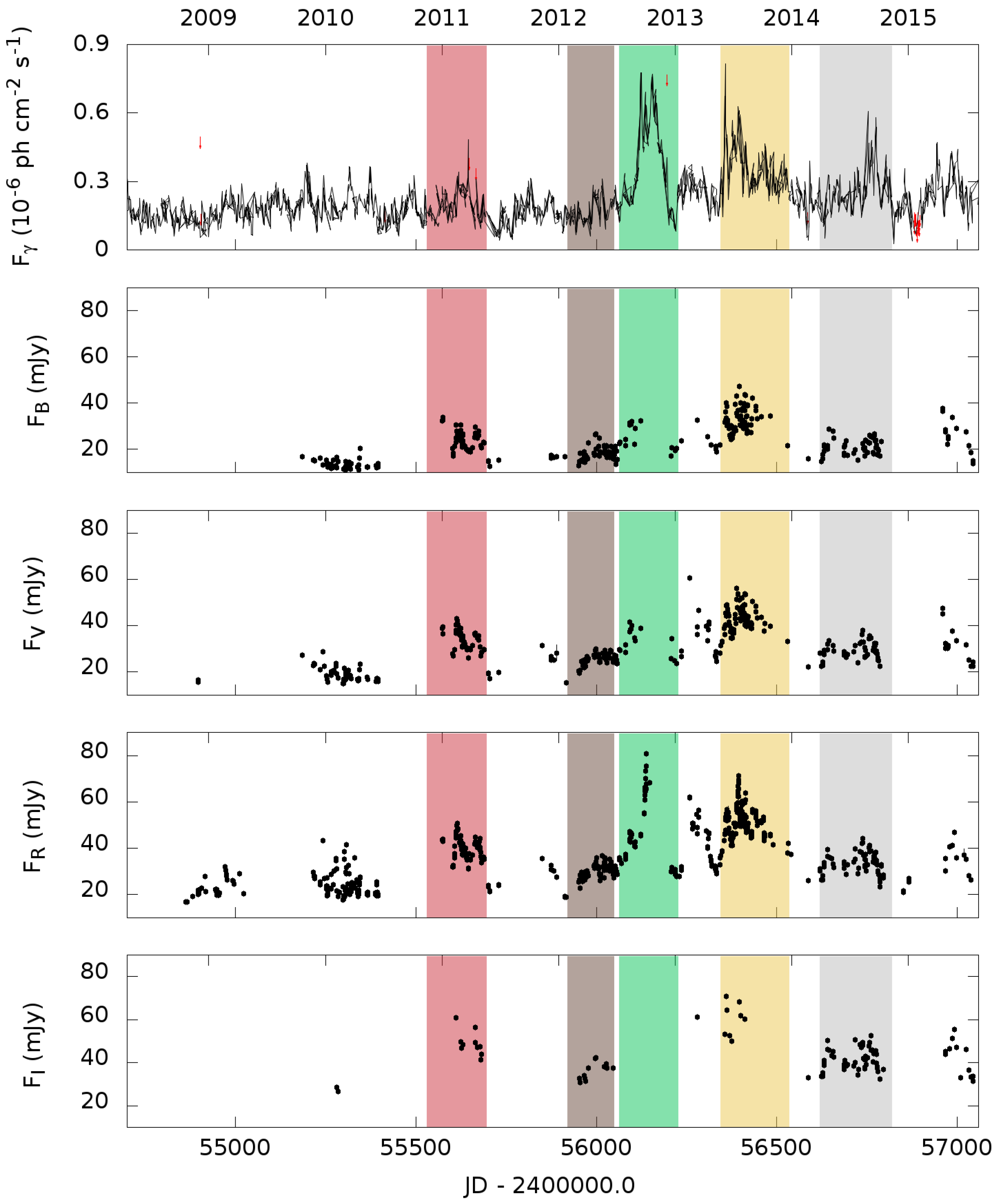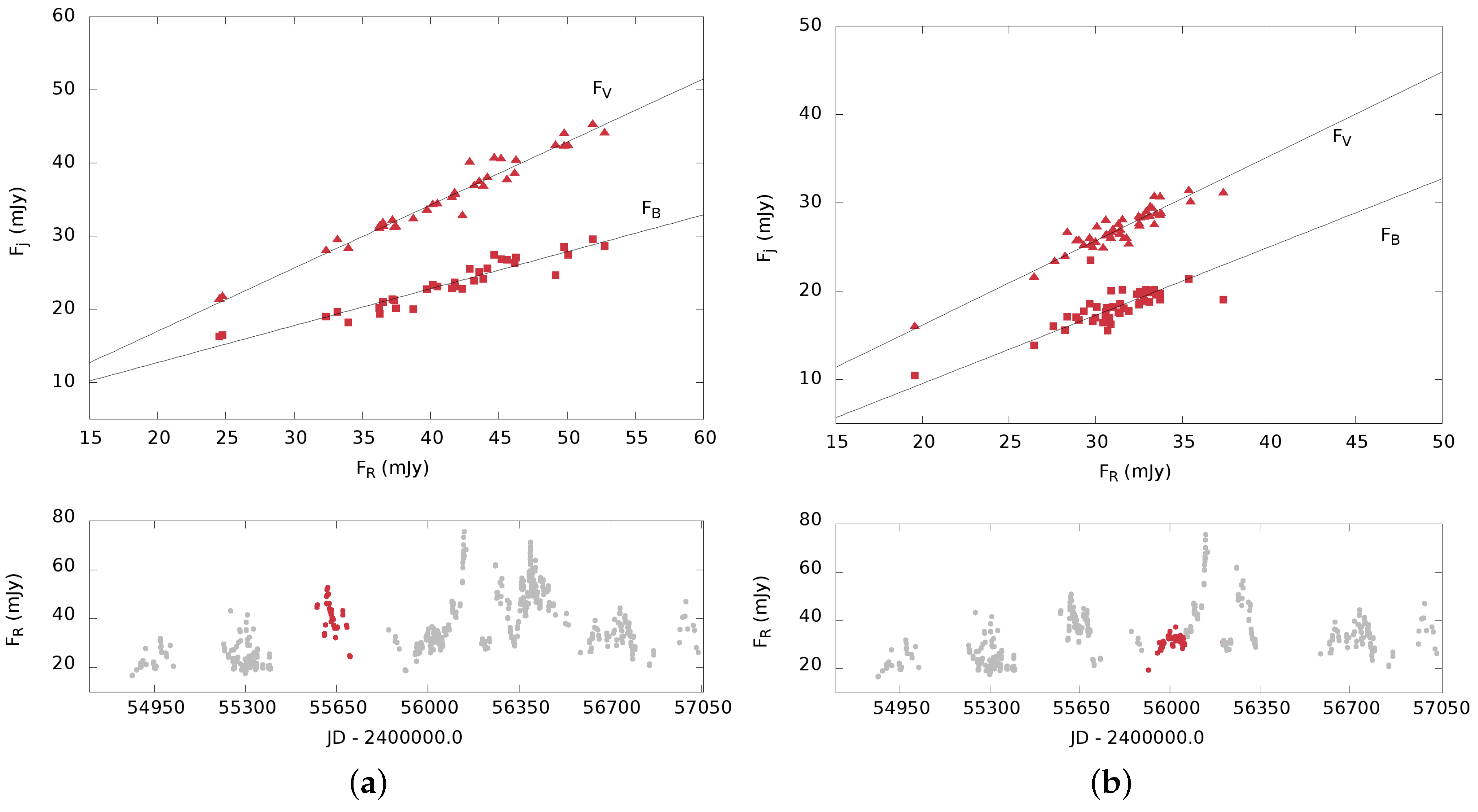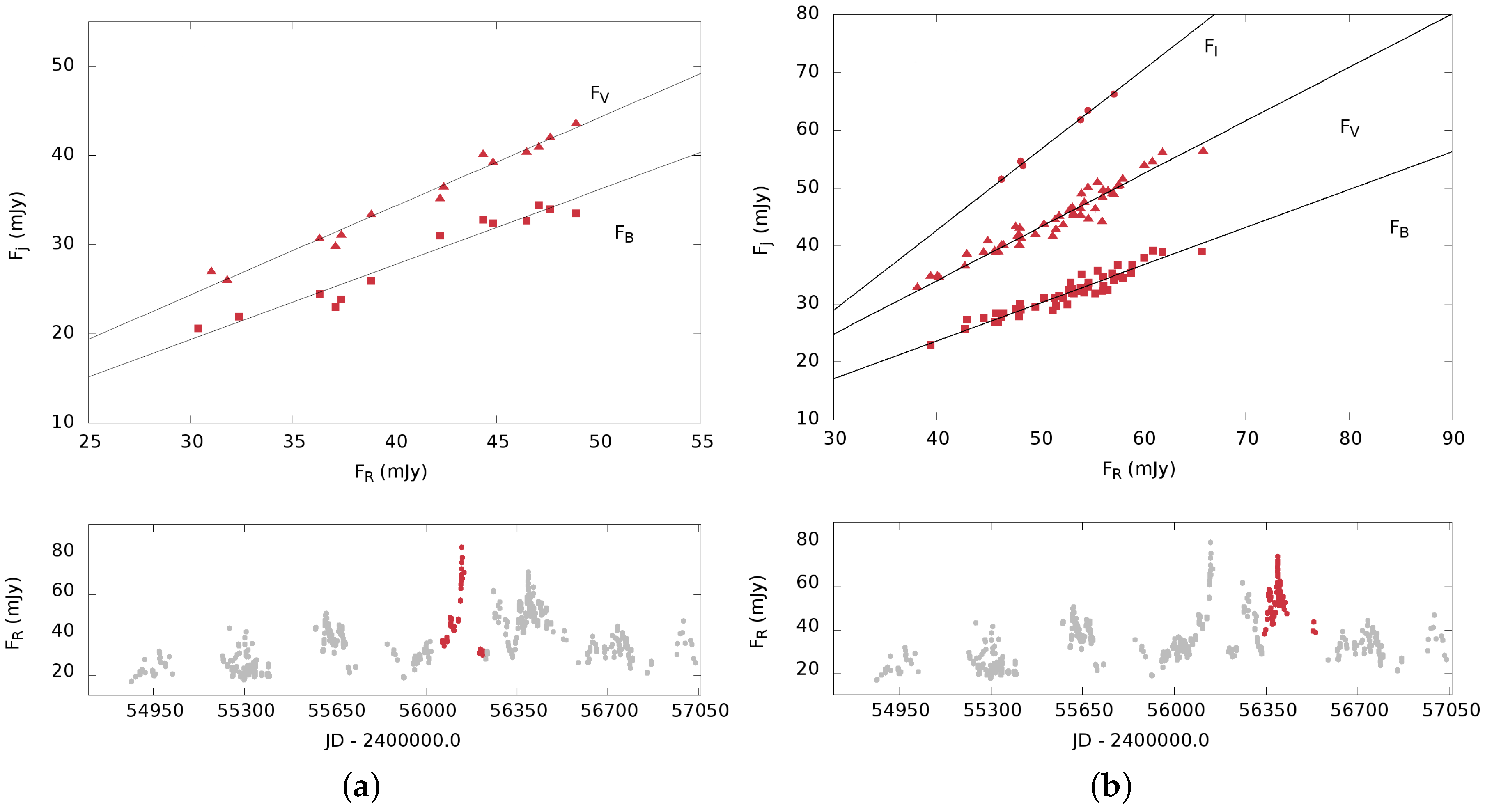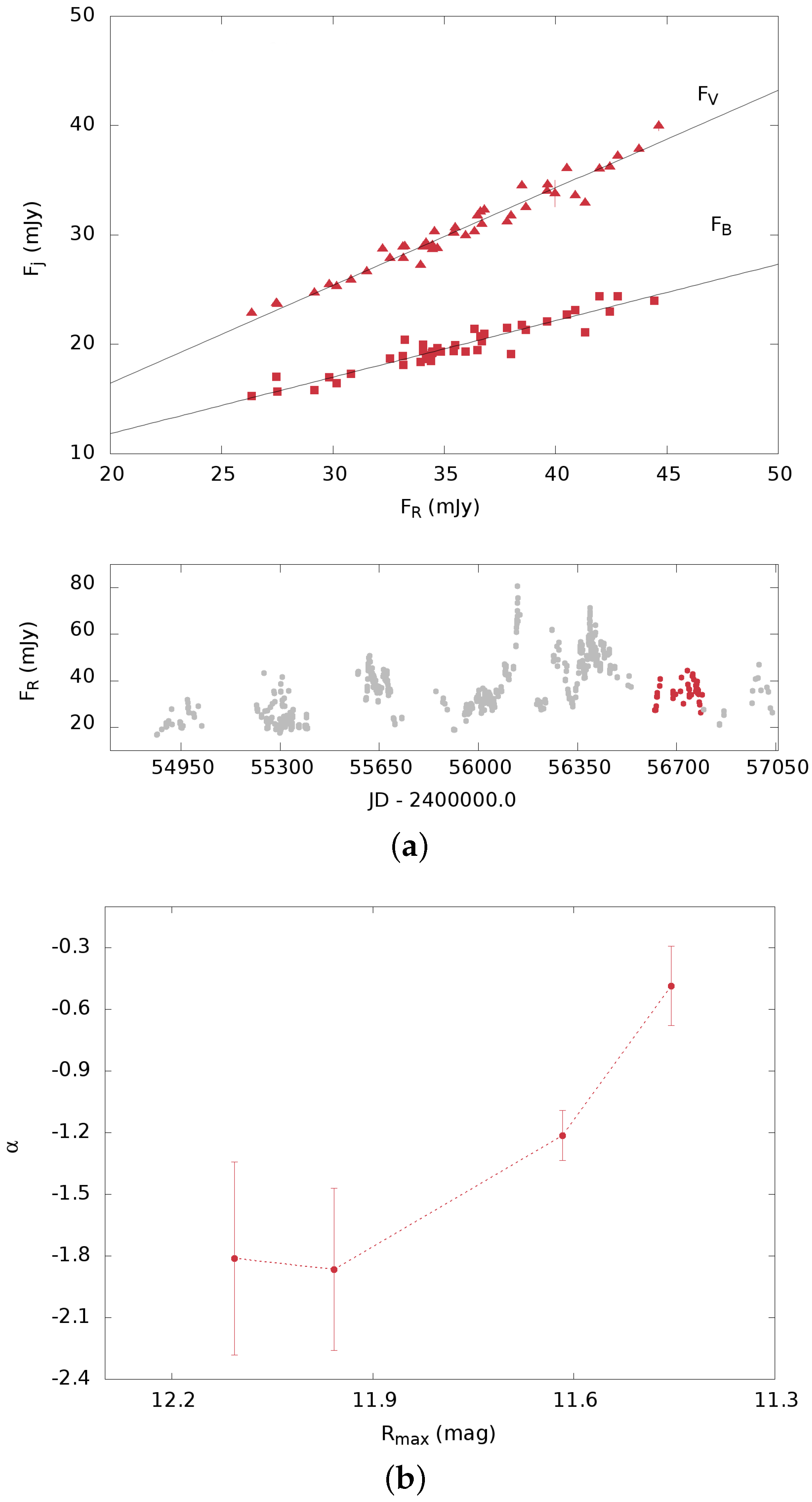Multiwavelength Monitoring of the Gamma-Bright Blazar Mkn 421
Abstract
:1. Introduction
2. Observations and Data Reduction
3. Results and Discussion
Acknowledgments
Author Contributions
Conflicts of Interest
References
- Abdo, A.A.; Ackermann, M.; Agudo, I.; Axelsson, M.; Baldini, L.; Ballet, J.; Barbiellini, G.; Bastieri, D.; Baughman, B.M.; Bechtol, K.; et al. The Spectral Energy Distribution of Fermi Bright Blazars. Astrophys. J. 2010, 716, 30. [Google Scholar] [CrossRef]
- Punch, M.; Akerlof, C.W.; Cawley, M.F.; Chantell, M.; Fegan, D.J.; Fennell, S.; Gaidos, J.A.; Hagan, J.; Hillas, A.M.; Jiang, Y.; et al. Detection of TeV photons from the active galaxy Markarian 421. Nature 1992, 358, 477–478. [Google Scholar] [CrossRef]
- Acciari, V.A.; Aliu, E.; Arlen, T.; Aune, T.; Beilicke, M.; Benbow, W.; Boltuch, D.; Bradbury, S.M.; Buckley, J.H.; Bugaev, V.; et al. TeV and Multi-wavelength Observations of Mrk 421 in 2006–2008. Astrophys. J. 2011, 738, 25. [Google Scholar] [CrossRef]
- Acciari, V.A.; Aliu, E.; Aune, T.; Beilicke, M.; Benbow, W.; Böttcher, M.; Bradbury, S.M.; Buckley, J.H.; Bugaev, V.; Butt, Y.; et al. Simultaneous Multiwavelength Observations of Markarian 421 During Outburst. Astrophys. J. 2009, 703, 169. [Google Scholar] [CrossRef]
- Horan, D.; Acciari, V.A.; Bradbury, S.M.; Buckley, J.H.; Bugaev, V.; Byrum, K.L.; Cannon, A.; Celik, O.; Cesarini, A.; Chow, Y.C.K.; et al. Multiwavelength Observations of Markarian 421 in 2005–2006. Astrophys. J. 2009, 695, 596–618. [Google Scholar] [CrossRef]
- Fossati, G.; Buckley, J.H.; Bond, I.H.; Bradbury, S.M.; Carter-Lewis, D.A.; Chow, Y.C.K.; Cui, W.; Falcone, A.D.; Finley, J.P.; Gaidos, J.A.; et al. Multiwavelength Observations of Markarian 421 in 2001 March: An Unprecedented View on the X-Ray/TeV Correlated Variability. Astrophys. J. 2008, 677, 906–925. [Google Scholar] [CrossRef]
- Hagen-Thorn, V.A.; Larionov, V.M.; Efimova, N.V.; Hagen-Thorn, I.; Arkharov, A.A.; di Paola, A.; Dolci, M.; Takalo, L.O.; Sillanpää, A.; Ostorero, L. Optical and IR monitoring of the BL Lac object S5 0716+714 from 2001–2004. Astron. Rep. 2006, 50, 458–467. [Google Scholar] [CrossRef]
- Atwood, W.B.; Abdo, A.A.; Ackermann, M.; Althouse, W.; Anderson, B.; Axelsson, M.; Baldini, L.; Ballet, J.; Band, D.L.; Barbiellini, G.; et al. The Large Area Telescope on the Fermi Gamma-Ray Space Telescope Mission. Astrophys. J. 2009, 697, 1071–1102. [Google Scholar] [CrossRef]
- Hagen-Thorn, V.A.; Marchenko, S.G. Photometry and Polarimetry of Active Galactic Nuclei. Balt. Astron. 1999, 8, 575–592. [Google Scholar]
- Blinov, D.A. The Structure of the Jets Blazars on the Results of Optical Monitoring. Ph.D. Thesis, St. Petersburg State University, St. Petersburg, Russia, 2011. [Google Scholar]




| Intervals | α |
|---|---|
| 2011 | |
| 2012 | |
| 2012 flare | |
| 2013 | |
| 2014 |
© 2016 by the authors; licensee MDPI, Basel, Switzerland. This article is an open access article distributed under the terms and conditions of the Creative Commons Attribution (CC-BY) license (http://creativecommons.org/licenses/by/4.0/).
Share and Cite
Troitskaya, Y.; Larionov, V.; Hagen-Thorn, V.; Morozova, D.; Blinov, D.; Borman, G.; Grishina, T.; Efimova, N.; Kopatskaya, E.; Larionova, L.; et al. Multiwavelength Monitoring of the Gamma-Bright Blazar Mkn 421. Galaxies 2016, 4, 67. https://doi.org/10.3390/galaxies4040067
Troitskaya Y, Larionov V, Hagen-Thorn V, Morozova D, Blinov D, Borman G, Grishina T, Efimova N, Kopatskaya E, Larionova L, et al. Multiwavelength Monitoring of the Gamma-Bright Blazar Mkn 421. Galaxies. 2016; 4(4):67. https://doi.org/10.3390/galaxies4040067
Chicago/Turabian StyleTroitskaya, Yulia, Valeri Larionov, Vladimir Hagen-Thorn, Daria Morozova, Dmitry Blinov, George Borman, Tatiana Grishina, Natalia Efimova, Evgenia Kopatskaya, Liudmila Larionova, and et al. 2016. "Multiwavelength Monitoring of the Gamma-Bright Blazar Mkn 421" Galaxies 4, no. 4: 67. https://doi.org/10.3390/galaxies4040067






